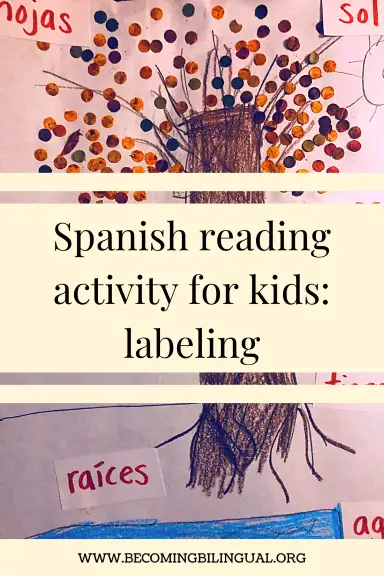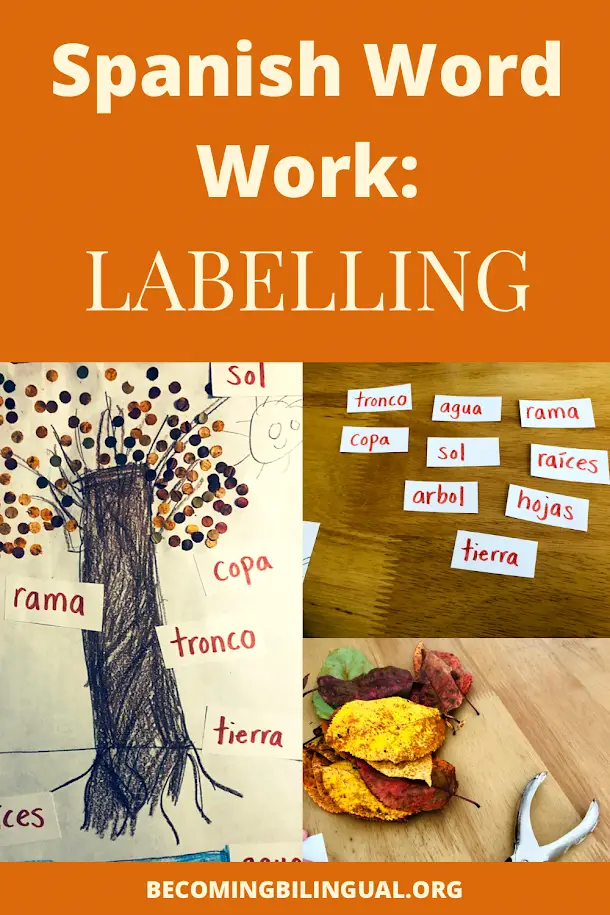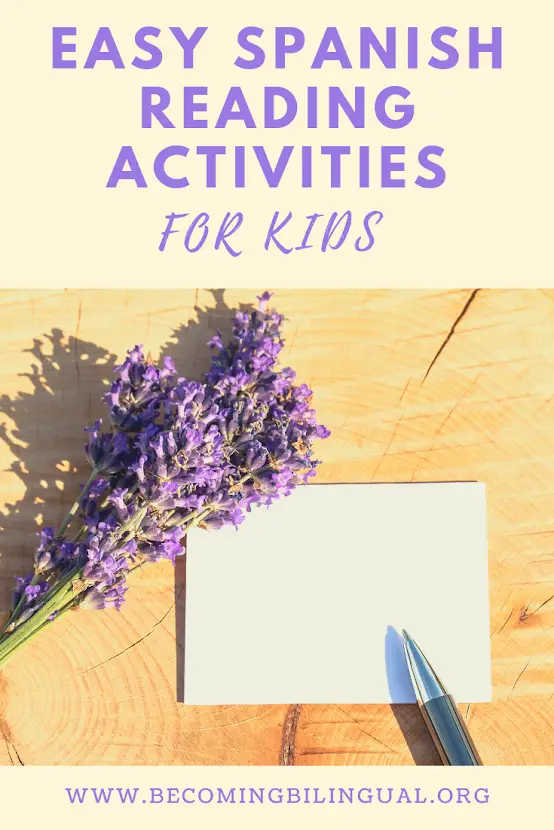Fun Labeling Activities To Practice Spanish Reading With Kids

After my daughter started her Montessori preschool at the age of the three, she decided that she wanted to learn how to read.
Her classroom was mixed ages 3-6 and she saw children curled up in a comfy chair in their reading nook and she decided that she wanted to be able to read, too.
At this point my daughter already knew the letter names and letter sounds in Spanish, so I was looking for the next step for her to really jump into reading. After some searching, I found Reading A-Z, a great website that has a lot of leveled texts in Spanish as well as many other languages.
To read my full post about Reading A-Z and how I used it to support my daughter’s reading, check out my post here: What I Used To Teach My Daughter To Read In Spanish.
Once my daughter had the basic concept of reading down, I knew that I needed to expose her to as many written words as possible.
When I think back to my own schooling, I remember having sight word lists to memorize and later spelling words and vocabulary words that I needed to know from memory.
Since I didn’t want to do flashcards with my daughter, I came up with other literacy games that we could do in our home to promote her decoding and early Spanish reading skills.

Table of Contents
Labeling:
The first game that I started with her was labeling. This was a fun way to start to get her to read longer words and to work on blending words once she sounded out the letter sounds. This game is also super simple and doesn’t require many materials, which makes it easy to play on the fly with little preparation.
Materials:
Marker
Index Card
Masking Tape
To Play:
Write a 2 syllable word on an index card. The word must match something that you have in your home. For example, “sofa”, “cama”, “caja”, etc. Show the word to your child for them to read. Once they read the word correctly, roll some tape and stick it on the back and have them go and stick the word onto the object that it labels.
This is a great start to decoding words because there are often many things in your home that are 2 syllable words that you can start with. Spanish is a highly phonetic language and works well with syllables. When your child is decoding, encourage them to sound out the first syllable and then the second syllable, since it’s easier for them to blend syllables than a string of letter sounds.
If you’re working on a word like “sofa”, you can use your hand to cover up ‘fa’, leaving only the first syllable, ‘so’. After your child decodes “so”, cover it up so that they can only see the “fa”. After decoding the “fa”, remind them of the two syllable sounds that they made and see if your child can blend them together. Blending syllable sounds is one of the most basic ways to start helping your child to read Spanish words.
You can also practice blending syllables without using written language. When you’re on the go you can make up syllable games like, “guess the word I’m saying” where you say two syllables spaced apart “ga-to” and see if your child can blend them together and say the word fast, “gato!”.
As your child gets more confident with syllables and blending sounds, try labelling with 3 syllable words “lampara”, or start making phrases by adding some one syllable words to your label, “el bano”.

Treasure Hunt:
Once my daughter got the hang of reading small phrases we changed the game from labelling to scavenger hunt. The basic reading premise is still there, she needs to decode and blend the words on the index card. But the game itself is more complicated since now I’m hiding the clues. Usually I start with 5-7 clues and a treasure.
Materials:
Marker
Index Card
Treasure
To Play:
My daughter and I usually agree on a “treasure” beforehand, like a favorite toy or a treat that I’m going to hide. Then I take the index cards and write out 5 clues. The first clue I’ll hand to my daughter, the other clues will be hidden in their specific locations.
When I first started to play this game with my daughter, I used short simple phrases that combined 1 and 2 syllable words, “en tu cama” (in your bed) so that she had a good idea of where to find the next clue. As she has progressed, I’ve included longer sentences and words with varying syllables, “la pista esta en tu armario” (the clue is in your closet).
My daughter could play this game every day, multiple times a day – she really loves hunting treasure! And when you play with many clues, you’d be surprised at how many Spanish sentences they’re reading and connecting to.

Scavenger Hunt:
Another sort of variation of these games that we’ve played before, which would still offer some good reading practice, would be to give your child a list of items written in Spanish that they need to hunt around the house for and bring back to you.
Materials:
Marker
Paper
To Play:
Think about things that your child could find around the house, carry, and bring back to you or a central location. Make a list of those materials on a piece of paper and give it to your child to read so that they can start hunting. This can also be a great way to incorporate “number words” that you want your child to be able to read easily. Here’s an example list that uses number words:
List:
Tres cucharas
Dos calcetines
Un libro
Cuatro lápices
Un oso de peluche
When your child brings back all of the materials in the correct amounts – they win!
This is a great way to practice isolated words that are 3 syllables and longer and that may be harder to decode or sound out an blend. When I play this with my daughter I try and include words that may have harder elements like “reciclaje” where there is a ‘soft c’ and a ‘hard c’ in the same word. It makes the hunt a bit more challenging and targets the Spanish reading practice that I want her to get.

Have you tried any of these reading games or any other Spanish reading game?
Let me know in the comments below! I’d love to hear about your language learning experiences and how you practice your language at home.
Happy Learning!
For more tips on teaching your child to read in Spanish:
What I Used To Teach My Daughter To Read In Spanish
How To Use These Epic Online Spanish Books For Beginners
Where To Find Books In Spanish
Don’t forget to subscribe here to get the latest posts and resources delivered straight to your inbox!
3 thoughts on “Fun Labeling Activities To Practice Spanish Reading With Kids”